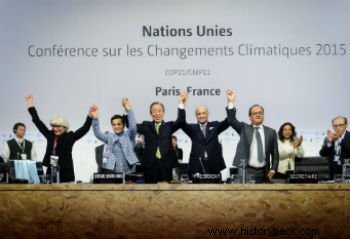The Paris Agreement is an international commitment discussed between 195 countries with the objective of minimizing the consequences of global warming.
It was adopted during the Conference of the Parties - COP 21, in Paris, in the year 2015.

World leaders approve the Paris Agreement
Paris Agreement:Current Situation
The most recent international treaty is the Paris Agreement, adopted in 2015, during the 21st Conference of the Parties took place in Paris.
The Paris agreement aims to strengthen the global response to the threat of climate change. It has been approved by the 195 participating countries that have committed to reducing greenhouse gas emissions.
This boils down to keeping the Earth's average temperature below 2°C, above pre-industrial levels. In addition to efforts to limit temperature rise to 1.5°C above pre-industrial levels.
Developed countries have also committed to providing financial benefits to the poorest countries so that they can face climate change.
However, for it to come into effect, it needs the ratification of at least 55 countries responsible for 55% of greenhouse gas emissions.
Brazil completed its ratification of the Paris Agreement on September 12, 2016.
In a document sent to the UN, the Brazilian goals are:
- Reduce greenhouse gas emissions by 37% below 2005 levels by 2025.
- In succession, reduce greenhouse gas emissions by 43% below 2005 levels by 2030.
The most recent event regarding the Paris Agreement was the departure of the United States, announced in June 2017. This news was received with great concern, as the United States is one of the biggest polluters on the planet.
Learn more about the Greenhouse Effect and Global Warming.
Historical Context
To understand global warming it is necessary to remember the process of the Industrial Revolution.
The change in the way products were manufactured led to the creation of machines. These were powered by coal and later oil.
Both are non-renewable sources of energy and give off carbon that is responsible for increasing temperatures on Earth.
Likewise, by choosing oil as an energy source for automobiles, the problem of pollution and global warming has only worsened.
It must be remembered that the first electric vehicle model dates from 1835 and was built in the United States.
However, with the popularization of the combustion cars manufactured by Henry Ford, electric cars become very expensive and are abandoned by the industry.
The problems of contamination and global warming are observable first in the modification of the natural environment and in people's health.
Thus, in the 1960s, civil society and governments began to worry about the consequences of industrialization.
Supported by the UN, the first conference on the environment is held in Stockholm, Sweden.
Other meetings were held throughout the 1960s with the aim of fine-tuning global policies to contain the advance of global warming.
Read more at Second Industrial Revolution.
Environmental Treaties
Concern about environmental issues has been the agenda of several international agreements in recent decades.
Stockholm Conference
The Stockholm Conference was held June 5-16, 1972, in Stockholm, Sweden.
It was the first United Nations Conference on the Human Environment, held by the United Nations (UN). It represented the beginning of international discussions on the Environment.
Montreal Protocol
The Montreal Protocol is an international agreement, signed in 1987. Its objective is to reduce the emission of CFC gases, responsible for the destruction of the ozone layer.
Rio-92
Rio-92 took place 20 years after the Stockholm Conference. Also called the United Nations Conference on Environment and Development, the event was held in Rio de Janeiro in 1992.
On the occasion, 172 countries met to assess the main environmental problems and discuss goals to reduce the impacts generated by them.
As a result, Agenda 21 emerged, which involved the social, economic, cultural, educational and environmental dimensions of populations.
The objective was to lead to sustainable development as a way to improve people's quality of life and the environment.
Kyoto Protocol
The Kyoto Protocol is an international treaty signed in 1997 in the city of Kyoto, Japan. The objective was to warn of the increase in the greenhouse effect and global warming.
It was important because it was the first agreement to establish greenhouse gas reduction targets. The Kyoto Protocol only came into force in 2005, during the COP 11 in Montreal.
Rio + 10
Rio + 10 took place between August 26 and September 4, 2002, in Johannesburg, South Africa.
The objective of the meeting was to evaluate the progress of the agreements defined in Rio-92. The event also served to reinforce the need and urgency of meeting what was agreed during Rio-92.
COP 15
The Climate Conference of the Parties was held by the United Nations Framework Convention on Climate Change. The event took place from the 7th to the 18th of December 2009, in Copenhagen, Denmark.
The purpose of the meeting was to discuss alternatives to face global warming.
The scenario put forward by scientists is that the Earth's temperature could not rise more than 2°C from pre-industrial levels by the end of the century.
Otherwise, an irreversible point of climate change will be reached.
Rio + 20
Rio + 20, also called the United Nations Conference on Sustainable Development, took place from June 13 to 22, 2012, in Rio de Janeiro.
It was one of the biggest events ever held by the UN and was attended by more than 180 countries.
Its objective was to strengthen and ensure sustainable development among the countries involved. A much discussed topic was the Green Economy, which means economic growth combined with a reduction in the emission of polluting gases.
Learn more about environmental issues, also read:
- Environment
- Climate Changes
- Environmental Impacts
- Ozone Layer
